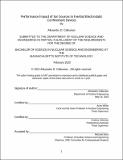| dc.contributor.advisor | Anne White and Andrew Seltzman. | en_US |
| dc.contributor.author | Calburean, Alexandru D. | en_US |
| dc.contributor.other | Massachusetts Institute of Technology. Department of Nuclear Science and Engineering. | en_US |
| dc.date.accessioned | 2021-02-19T20:28:57Z | |
| dc.date.available | 2021-02-19T20:28:57Z | |
| dc.date.copyright | 2019 | en_US |
| dc.date.issued | 2020 | en_US |
| dc.identifier.uri | https://hdl.handle.net/1721.1/129867 | |
| dc.description | Thesis: S.B., Massachusetts Institute of Technology, Department of Nuclear Science and Engineering, February, 2020 | en_US |
| dc.description | Cataloged from student-submitted PDF of thesis. "February 2020." | en_US |
| dc.description | Includes bibliographical references (pages 38-39). | en_US |
| dc.description.abstract | In order to improve the performance of Inertial Electrostatic Confinement (IEC) based fusion devices, so as to improve their effectiveness as low cost, portable neutron sources, a novel use of ion sources is proposed as a means of increasing fusion reaction rate at similar power levels. This paper aims to determine the success and practicality of the proposed use type for ion sources and characterize the IEC device in question, in terms of performance, and neutron emission. The application outlined aims to improve upon the performance of IEC devices with an anode layer ion source. The above-mentioned approach was evaluated by first conditioning the IEC fusion device in question. Then a neutron flux baseline was recorded as a metric for performance, and to evaluate the assumption of neutron emission isotropy in the device. Then an ion source was installed in the chamber, and the system was once again conditioned in the same manner. A similar baseline reading and analysis was done to ensure a correct comparison could be made between performance with the ion source turned on and off. Next the system was run with the ion source at full power to allow for further characterization of the performance and stability of the device. Finally, a last run was carried out with the ion source properly tuned, and results were compared to both baseline runs. It has been shown that there is a potential performance gain from operation with an ion source, both in terms of system stability and improved neutron emission. Across all run campaigns, the assumption of isotropic emission was shown to be a poor representation of the actual emission. With a higher degree of certainty, it has been shown that operation with an ion source serves to reliably exaggerate the anisotropy found in baseline campaigns. | en_US |
| dc.description.statementofresponsibility | by Alexandru D. Calburean. | en_US |
| dc.format.extent | 48 pages | en_US |
| dc.language.iso | eng | en_US |
| dc.publisher | Massachusetts Institute of Technology | en_US |
| dc.rights | MIT theses may be protected by copyright. Please reuse MIT thesis content according to the MIT Libraries Permissions Policy, which is available through the URL provided. | en_US |
| dc.rights.uri | http://dspace.mit.edu/handle/1721.1/7582 | en_US |
| dc.subject | Nuclear Science and Engineering. | en_US |
| dc.title | Performance impact of ion sources in Inertial Electrostatic Confinement devices | en_US |
| dc.type | Thesis | en_US |
| dc.description.degree | S.B. | en_US |
| dc.contributor.department | Massachusetts Institute of Technology. Department of Nuclear Science and Engineering | en_US |
| dc.identifier.oclc | 1237644263 | en_US |
| dc.description.collection | S.B. Massachusetts Institute of Technology, Department of Nuclear Science and Engineering | en_US |
| dspace.imported | 2021-02-19T20:28:26Z | en_US |
| mit.thesis.degree | Bachelor | en_US |
| mit.thesis.department | NucEng | en_US |
